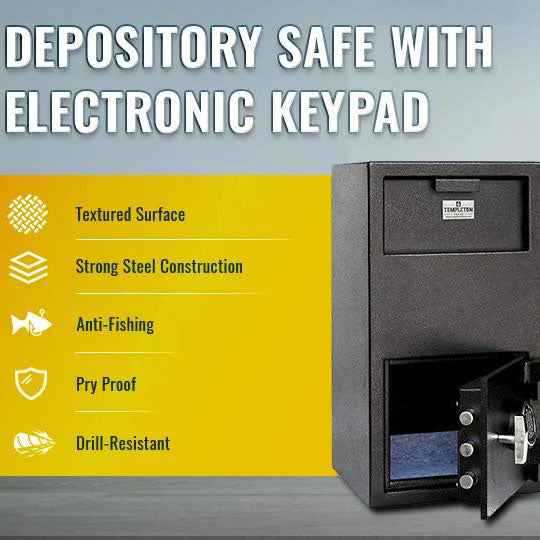How Safe Technology Changed After the Great Bank Heists of the 20th Century
The 20th century was a time of rapid change and innovation in many fields, and the world of security safes was no exception. As technology advanced, so did the methods used by criminals to breach safes and vaults. However, with each daring bank heist, security experts learned valuable lessons, leading to significant advancements in safe technology. This article explores how the notorious bank heists of the 20th century influenced the development of more secure safes and vaults, shaping the security safe technology we rely on today.
The Early 20th Century: When Safes Faced Their First Major Challenges
The Simplicity of Early Safe Technology
In the early 1900s, safes were relatively simple devices. They were primarily designed to protect valuables from fire and casual theft. Most safes used mechanical combination locks, thick steel walls, and basic anti-tampering features. While these safes provided adequate security for their time, they were not equipped to handle the more sophisticated methods of attack that would soon emerge.
The Rise of Organized Crime
As organized crime began to grow in the early 20th century, so did the ambition and expertise of criminals. Bank heists became more frequent and more daring, with gangs using a combination of brute force and technical know-how to break into safes. The infamous 1930s bank robberies in the United States, carried out by figures like John Dillinger and Bonnie and Clyde, highlighted the weaknesses in existing safe technology.
The Turning Point: The Great Bank Heists of the Mid-20th Century
The Notorious Heists That Changed Everything
The mid-20th century saw some of the most audacious and well-planned bank heists in history. These heists exposed the vulnerabilities in safe technology and forced the industry to adapt quickly.
-
The Brink’s Job (1950): One of the most famous heists in American history, the Brink’s Job involved a gang of robbers who meticulously planned and executed the theft of $2.7 million from a Brink’s armored car depot in Boston. This heist, known as "the crime of the century," highlighted the need for better internal security and tamper-proof designs in safes and vaults.
-
The Great Train Robbery (1963): In the UK, the Great Train Robbery saw a gang of thieves make off with £2.6 million in cash from a Royal Mail train. While this wasn’t a traditional bank heist, it demonstrated the lengths criminals were willing to go to bypass security systems, pushing for advancements in safe and vault technology.
The Response: Advancements in Safe Design
In the wake of these high-profile heists, safe manufacturers recognized the need for more sophisticated security measures. The industry responded by developing new technologies and enhancing existing ones to better protect against the increasingly inventive methods of criminals.
Key Advancements in Security Safe Technology
Reinforced Safe Construction
One of the first responses to the spate of bank heists was to strengthen the physical construction of safes. Manufacturers began using thicker, reinforced steel to make safes more resistant to cutting, drilling, and other forms of physical attack. The introduction of composite materials, such as reinforced concrete with embedded steel, added an extra layer of protection, making it significantly more difficult for criminals to break through.
Advanced Locking Mechanisms
The mechanical combination lock, while reliable, became a weak point as criminals developed techniques to manipulate them. In response, safe manufacturers introduced more complex locking mechanisms:
-
Time Locks: Time locks became a standard feature in high-security safes and vaults. These locks could only be opened during certain hours, reducing the risk of after-hours theft.
-
Dual-Control Locks: These locks required two keys or combinations, often held by different individuals, to open the safe. This feature made it much harder for a single person or a small group to gain unauthorized access.
-
Electronic Locks: The introduction of electronic locks in the 1970s marked a significant leap forward in security safe technology. These locks offered programmable combinations, automatic relocking, and the ability to log access attempts, making them more secure and easier to use than their mechanical counterparts.
Anti-Drill and Anti-Explosive Technology
As criminals began using power tools and explosives to breach safes, manufacturers developed countermeasures to thwart these methods:
-
Hard Plate Technology: Hard plates made from specially treated steel or composite materials were placed behind the lock and other vulnerable areas of the safe. These plates were designed to resist drilling, making it extremely difficult for criminals to reach the lock mechanism.
-
Relocking Devices: In the event that a safe’s lock was tampered with, relocking devices would automatically engage additional locking bolts, further securing the safe. This feature was particularly effective against brute force attacks.
-
Explosive-Resistant Safes: With the increased use of explosives in bank heists, manufacturers introduced explosive-resistant safes. These safes were designed to absorb and dissipate the force of an explosion, preventing the safe from being blown open.
The Integration of Technology: Safes in the Digital Age
The Shift to Digital Security
The latter half of the 20th century saw the integration of digital technology into safe design, which transformed the industry. Electronic locks became more sophisticated, offering features like time delay, multiple user codes, and audit trails that recorded every access attempt.
Biometric Safes: The Next Generation
One of the most significant advancements in security safe technology has been the introduction of biometric safes. These safes use fingerprint recognition, retinal scans, or other biometric data to grant access. This technology offers a level of security that is virtually impossible to breach through traditional methods, making it a popular choice for both commercial and residential use.
Whether you're looking for a small personal safe or a large commercial vault, Templeton Safes has a wide range of options to suit your needs. From biometric locks and digital keypads to time-delay features, our safes are customizable to provide the security you require.
Why Choose Templeton Safes for Your Security Needs?
As you've learned throughout this article, the evolution of safe technology has been driven by the need to protect valuables against increasingly sophisticated threats. At Templeton Safes, we continue this legacy by offering state-of-the-art security safes designed to meet the highest standards of protection.
Trusted by Professionals
Templeton Safes are trusted by professionals across various industries, including banks, businesses, and private collectors. Our reputation for quality and reliability speaks for itself, making us the go-to choice for those who demand the best in security.
Protect Your Valuables with Confidence
Don’t leave your security to chance. With Templeton Safes, you can have peace of mind knowing that your most valuable assets are protected by the best in the business. Visit our website at www.templetonsafes.com to explore our full range of safes and find the perfect solution for your security needs.
Invest in a Templeton Safe today and experience the difference that superior security technology can make!
The Legacy of the Great Bank Heists: Shaping Modern Security
Lessons Learned from the Past
The great bank heists of the 20th century were not just crimes; they were catalysts for change. Each heist exposed vulnerabilities in existing security measures and pushed the industry to innovate. The lessons learned from these events continue to influence safe technology today.
The Ongoing Evolution of Safe Technology
While the criminals of the 20th century may have been ahead of their time, the advancements in safe technology that followed have set a new standard for security. Today’s safes are the result of decades of innovation, driven by the need to outsmart increasingly sophisticated criminals. As technology continues to evolve, so too will the safes that protect our most valuable possessions.
The Future of Safe Technology
The history of safe technology is a story of adaptation and innovation, driven by the challenges posed by criminals over the years. From the early mechanical safes of the 20th century to the biometric and AI-integrated safes of today, the industry has come a long way in ensuring that our valuables are secure. As we look to the future, it’s clear that the lessons of the past will continue to guide the development of even more advanced security safe technology, ensuring that we stay one step ahead of those who seek to break the law.






























